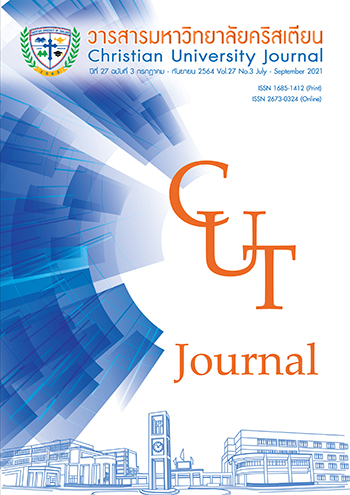อิทธิพลของปทัสถานทางจิตใจและอารมณ์ผู้ใช้งานมีผลต่อความตั้งใจซื้อโทรศัพท์สมาร์ทโฟนของผู้บริโภคในเขตกรุงเทพมหานคร
คำสำคัญ:
ปทัสถานทางจิตใจ, อารมณ์ผู้ใช้งาน, ความปิติยินดี, ความเร้าใจ, การมีอำนาจควบคุม, ความตั้งใจซื้อโทรศัพท์สมาร์ทโฟนบทคัดย่อ
การวิจัยครั้งนี้มีวัตถุประสงค์ (1) เพื่อศึกษาระดับของปทัสถานทางจิตใจ อารมณ์ผู้ใช้งาน และความตั้งใจซื้อโทรศัพท์สมาร์ทโฟน และ (2) เพื่อศึกษาอิทธิพลตัวแปรคั่นกลางของอารมณ์ผู้ใช้งานที่เป็นปัจจัยเชื่อมโยงระหว่างปทัสถานทางจิตใจสู่ความตั้งใจซื้อโทรศัพท์สมาร์ทโฟนของผู้บริโภคในเขตกรุงเทพมหานครกลุ่มตัวอย่างที่ใช้ในการวิจัย คือ ผู้บริโภคโทรศัพท์สมาร์ทโฟนในเขตกรุงเทพมหานคร จำนวน 500 คน ด้วยวิธีการสุ่มตัวอย่างอย่างง่าย และใช้แบบสอบถามเป็นเครื่องมือวิจัย ซึ่งการหาค่าสัมประสิทธิ์แอลฟาของครอนบัคมีค่าอยู่ระหว่าง 0.713-0.915 และสถิติที่ใช้ในการวิจัย คือ การวิเคราะห์ด้วยค่าร้อยละ ค่าเฉลี่ยส่วนเบี่ยงเบนมาตรฐาน และการวิเคราะห์สมการโครงสร้าง ผลการวิจัยพบว่า (1) ปทัสถานทางจิตใจ อารมณ์ผู้ใช้งาน และความตั้งใจซื้อโทรศัพท์สมาร์ทโฟนมีค่าเฉลี่ยรวมอยู่ในระดับปานกลาง และ (2) อิทธิพลของอารมณ์ผู้ใช้งานด้านความปิติยินดี ความเร้าใจ และการมีอำนาจควบคุมเป็นปัจจัยคั่นกลางที่เชื่อมโยงปทัสถานทางจิตใจสู่ความตั้งใจซื้อโทรศัพท์สมาร์ทโฟนของผู้บริโภคในเขตกรุงเทพมหานคร ซึ่งสามารถนำผลลัพธ์จาการวิจัยไปใช้ประโยชน์เพื่อเป็นแนวทางในการวางแผนและกำหนดกลยุทธ์ในการพัฒนาธุรกิจโทรศัพท์สมาร์ทโฟน เพื่อสร้างให้ผู้บริโภคโทรศัพท์สมาร์ทโฟนเกิดความตั้งใจซื้อโทรศัพท์สมาร์โฟนเพิ่มมากขึ้น
เอกสารอ้างอิง
กระทรวงดิจิทัลเพื่อเศรษฐกิจและสังคม. (2561). การสำรวจการมีการใช้เทคโนโลยีสารสนเทศและการสื่อสารในครัวเรือน พ.ศ. 2561. กรุงเทพฯ: สำนักงานสถิติแห่งชาติ.
ธัญนันท์ บุญอยู่. (2562). อิทธิพลของวัฒนธรรมแห่งการเรียนรู้และคุณภาพชีวิตในงานที่มีต่อความสุขในการทำงานของพนักงานวิสาหกิจขนาดย่อมของอุตสาหกรรมเครื่องนุ่งหุ่มในเขตกรุงเทพมหานคร. วารสารการเมือง การบริหาร และกฎหมาย, คณะรัฐศาสตร์และนิติศาสตร์ มหาวิทยาลัยบูรพา, 11(2), 191-207.
มนตรี พิริยะกุล. (2558). ตัวแปรคั่นกลางและการทดสอบอิทธิพลทางอ้อม. วารสารการจัดการและการพัฒนา, 2(1), 11-31.
ศุภศิลป์ กุลจิตต์เจือวงศ์. (2556). โทรศัพท์มือถืออัจฉริยะ ทศวรรษใหม่ของนวัตกรรมการสื่อสารแห่งอนาคต. วารสารวิชาการ Veridian E-Journal ฉบับมนุษยศาสตร์ สังคมศาสตร์ และวิทยาศาสตร์, บัณฑิตวิทยาลัย มหาวิทยาลัยศิลปากร, 6(1), 132-142.
Aertsens, J., Verbeke, W., Mondelarers, K., & Huylenbrodck, G. V. (2009). Personal determinants of organic food consumption: A review. British Food Journal, 111(10), 1140-1167.
Al-Nahdi, T. S. (2014). Factors influencing the intention to purchase real estate in Saudi Arabia role of location. Journal of Applied Science and Agriculture, 9(18), 32-42.
Best, J. W. (1981). Research in education. (4th ed.). Englewood Cliffs, New Jersey: Prentice-Hall.
Chang, S. H., Chih, W. H., Liou, D. W., & Hwang, L. R. (2014). The influence of web aesthetics on customers’ PAD. Computers in Human Behavior, 36, 168-178.
Chen, C. C., Chen, C. W., & Tung, Y. C. (2018). Exploring the consumer behavior of intention to purchase green products in belt and road countries: An empirical analysis. Sustainability, 10, 1-18.
Comrey, A. L., & Lee, H. B. (1992). A first course in factor analysis. Hillsadle, NJ: Lawrence Erlbaum Associates.
Cronbach, L. J. (1951). Coefficient alpha and the internal structure of tests. Psychometrika, 16(3), 297-334.
Dachyar, M., & Banjarnahor, L. (2017). Factors influencing purchase intention towards consumer-to-consumer e-commerce. Intangible Capital, 13(5), 946-968.
Dkudiene, V., Eertokas, D., McCorkle, D., & Reardon, J. (2015). The effect of e-shops’s service quality on Lithuanian consumer’s purchase intentions. International Journal of Business, Marketing & Decision Science, 8(1), 43-59.
Ham, M., Jeger, M. & Ivkovic, A. F. (2015). The role of subjective norms in forming the intention to purchase green food. Economic Research-Ekonomska Istrazivumja, 28(1), 738-748.
Hsieh, J.-K., Hsieh, Y.-C., Chiu, H.-C., & Yang, Y.-R. (2014). Customer response to web site atmospherics: Task-relevant cues, situational involvement and PAD. Journal of Interactive Marketing, 28, 225-236.
Khan, H. T., Humayun, A. A. & Sajjad, M. (2015). Customer loyalty-attitudinal and behavioral aspects. International Journal of Information, Business and Management, 7(1), 163-175.
Kulviwat, S., Bruner, G. C., Kumar, A., Nasco, S. A., & Clark, T. (2007). Toward a unified theory of consumer acceptance technology. Psychology & Marketing, 24(12), 1059-1084.
Lai, P. (2017). The literature review of technology adoption models and theories for the novelty technology. Journal of Information Systems and Technology Management, 14(1), 21-38.
Li, M., Dong, Z. Y., & Chen, X. (2012). Factors influencing consumption experience of mobile commerce. Internet Research, 22(2), 120-141.
Likert, R. A. (1932). A technique for the measurement of attitudes. Archives of Psychology, 140, 5-53.
Rahim, A., Safin, S. Z., Kheng, L. K., Abas, N. Ali, S. M. (2016). Factors influencing purchasing intention of Smartphone among university students. Procedia Economics and Finance, 37, 245-253.
Venkatesh, V., & Bala, H. (2008). Technology acceptance model 3 and a research agenda on interventions. Decision Sciences, 39(2), 273-315.



